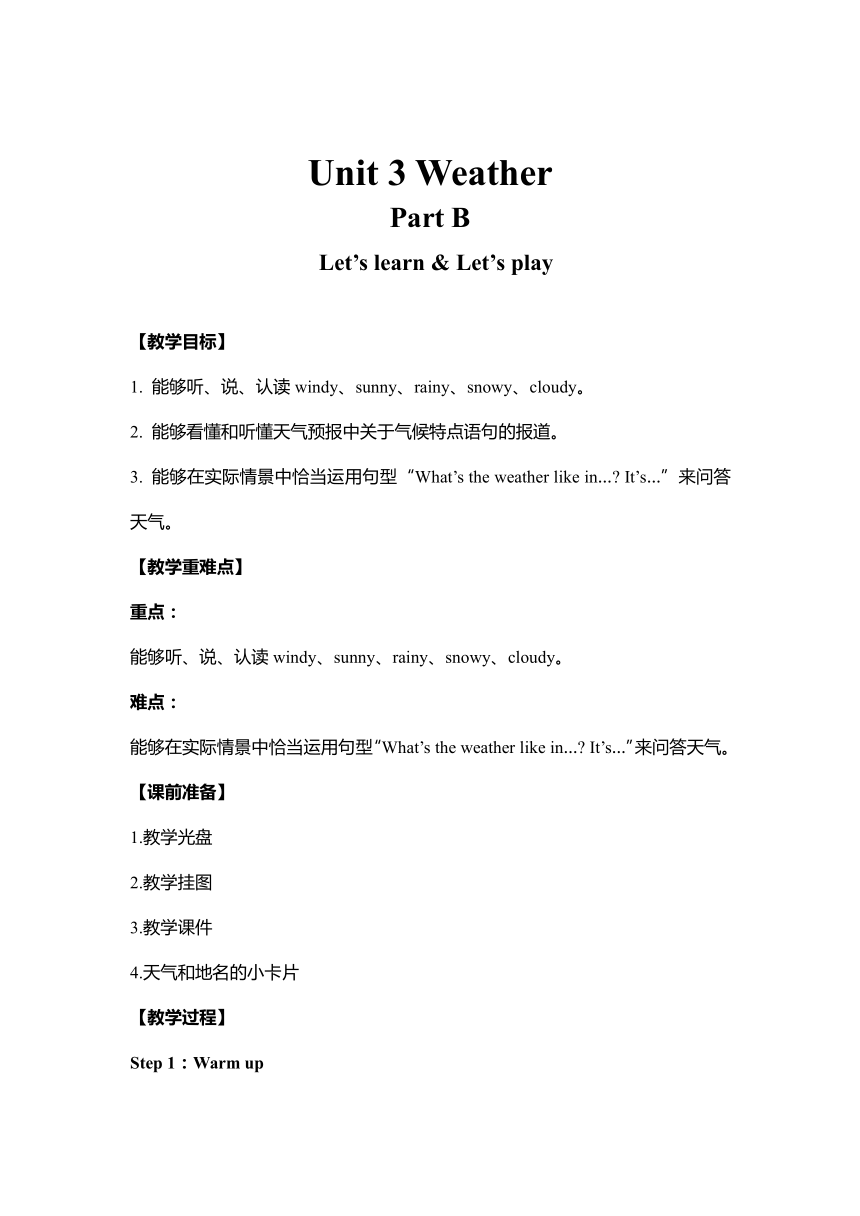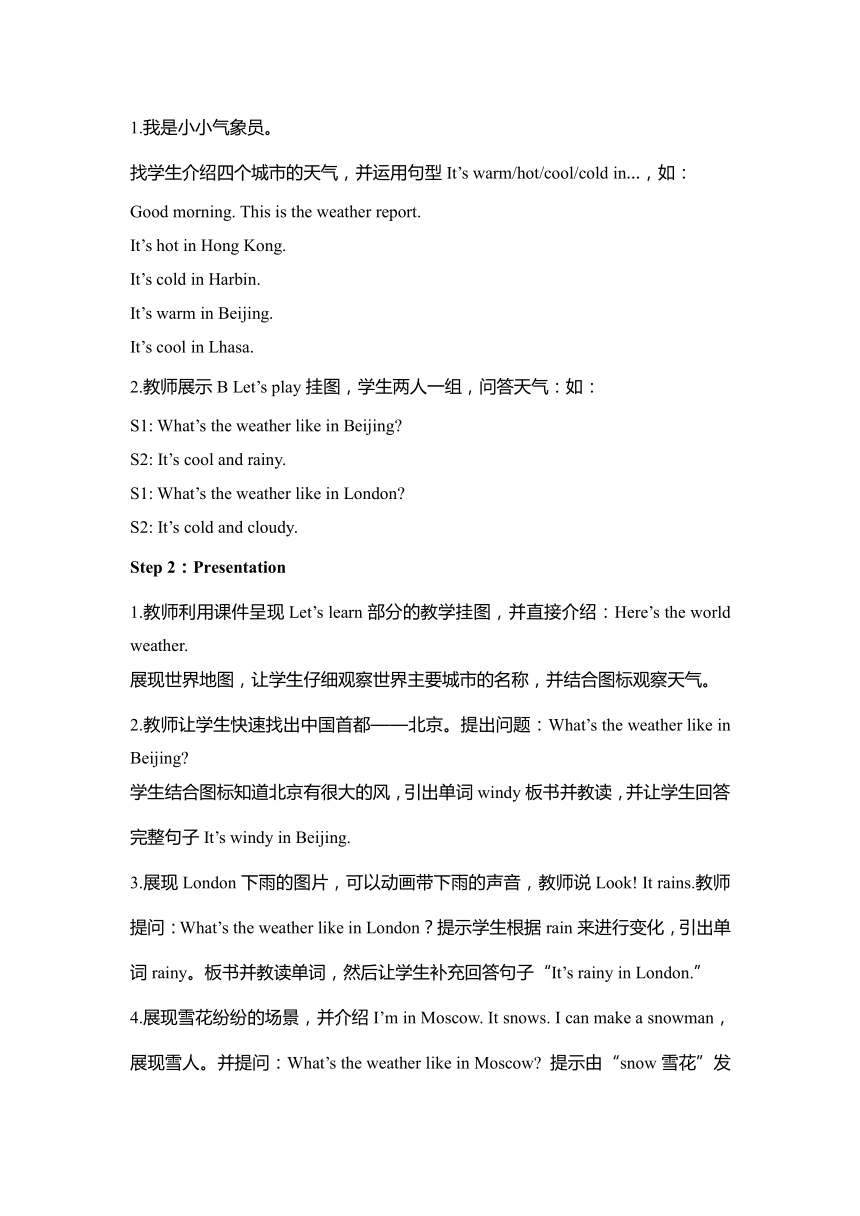Unit 3 Weather Part B Let’s learn 教案(含反思)
文档属性
| 名称 | Unit 3 Weather Part B Let’s learn 教案(含反思) |  | |
| 格式 | docx | ||
| 文件大小 | 15.1KB | ||
| 资源类型 | 教案 | ||
| 版本资源 | 人教版(PEP) | ||
| 科目 | 英语 | ||
| 更新时间 | 2022-05-12 12:31:26 | ||
图片预览


文档简介
Unit 3 Weather
Part B
Let’s learn & Let’s play
【教学目标】
1. 能够听、说、认读windy、sunny、rainy、snowy、cloudy。
2. 能够看懂和听懂天气预报中关于气候特点语句的报道。
3. 能够在实际情景中恰当运用句型“What’s the weather like in… It’s…”来问答天气。
【教学重难点】
重点:
能够听、说、认读windy、sunny、rainy、snowy、cloudy。
难点:
能够在实际情景中恰当运用句型“What’s the weather like in… It’s…”来问答天气。
【课前准备】
1.教学光盘
2.教学挂图
3.教学课件
4.天气和地名的小卡片
【教学过程】
Step 1:Warm up ?
1.我是小小气象员。
找学生介绍四个城市的天气,并运用句型It’s warm/hot/cool/cold in…,如:
Good morning. This is the weather report.
It’s hot in Hong Kong.
It’s cold in Harbin.
It’s warm in Beijing.
It’s cool in Lhasa.
2.教师展示B Let’s play挂图,学生两人一组,问答天气:如:
S1: What’s the weather like in Beijing
S2: It’s cool and rainy.
S1: What’s the weather like in London
S2: It’s cold and cloudy.
Step 2:Presentation ?
1.教师利用课件呈现Let’s learn部分的教学挂图,并直接介绍:Here’s the world weather.
展现世界地图,让学生仔细观察世界主要城市的名称,并结合图标观察天气。
2.教师让学生快速找出中国首都——北京。提出问题:What’s the weather like in Beijing
学生结合图标知道北京有很大的风,引出单词windy板书并教读,并让学生回答完整句子It’s windy in Beijing.
3.展现London下雨的图片,可以动画带下雨的声音,教师说Look! It rains.教师提问:What’s the weather like in London?提示学生根据rain来进行变化,引出单词rainy。板书并教读单词,然后让学生补充回答句子“It’s rainy in London.”
4.展现雪花纷纷的场景,并介绍I’m in Moscow. It snows. I can make a snowman,展现雪人。并提问:What’s the weather like in Moscow 提示由“snow雪花”发生变化,变成snowy,板书并教读。
5.展现Singapore多云的图片,并旁批cloud,提问:What’s the weather like in Singapore 引导单词cloudy=cloud+y,教读单词,并补充回答。
6.让学生找到Sydney,并出示太阳sun,提问:What’s the weather like in Sydney?引出单词sunny=sun+n(双写)y,板书并教读。
7.学生两人之间利用句型What’s the weather like in… It’s rainy/sunny/cloudy/windy/snowy.来问答天气。
8.播放:Let’s learn 部分的录音,学生跟读,学习正确的语音语调。
Step 3: Consolidation and extension ?
1.完成Let’s play。
同桌两人一组,一人手里拿着一些关于天气的各种卡片,另一人手里拿着地点卡片,两人合作,将地点和对应季节的天气相配合,并说句子叙述天气。
如:It’s warm in Kunming now.
2.学生开火车问天气。
S1:It’s cool and rainy in Beijing. How about London
S2:It’s cold and cloudy in London. How about Sydney
S3:…
Step 4:Homework ?
将昆明、北京、伦敦、悉尼、哈尔滨这五个世界城市的天气用英语描述给父母听。
【板书设计】
Unit 3 Weather
windy,sunny,rainy,snowy,cloudy
What’s the weather like in Sydney
It’s hot and sunny.
【教学反思】
本课时以英语单词的学习为重点,教师在新知识传授阶段不仅把新授单词融入到句子的教学中,更重要的是结合图片,将词源交给学生,让学生结合图片了解这些形容词的由来,加深了对单词的记忆,培养了学生的观察能力和归纳总结能力。
Part B
Let’s learn & Let’s play
【教学目标】
1. 能够听、说、认读windy、sunny、rainy、snowy、cloudy。
2. 能够看懂和听懂天气预报中关于气候特点语句的报道。
3. 能够在实际情景中恰当运用句型“What’s the weather like in… It’s…”来问答天气。
【教学重难点】
重点:
能够听、说、认读windy、sunny、rainy、snowy、cloudy。
难点:
能够在实际情景中恰当运用句型“What’s the weather like in… It’s…”来问答天气。
【课前准备】
1.教学光盘
2.教学挂图
3.教学课件
4.天气和地名的小卡片
【教学过程】
Step 1:Warm up ?
1.我是小小气象员。
找学生介绍四个城市的天气,并运用句型It’s warm/hot/cool/cold in…,如:
Good morning. This is the weather report.
It’s hot in Hong Kong.
It’s cold in Harbin.
It’s warm in Beijing.
It’s cool in Lhasa.
2.教师展示B Let’s play挂图,学生两人一组,问答天气:如:
S1: What’s the weather like in Beijing
S2: It’s cool and rainy.
S1: What’s the weather like in London
S2: It’s cold and cloudy.
Step 2:Presentation ?
1.教师利用课件呈现Let’s learn部分的教学挂图,并直接介绍:Here’s the world weather.
展现世界地图,让学生仔细观察世界主要城市的名称,并结合图标观察天气。
2.教师让学生快速找出中国首都——北京。提出问题:What’s the weather like in Beijing
学生结合图标知道北京有很大的风,引出单词windy板书并教读,并让学生回答完整句子It’s windy in Beijing.
3.展现London下雨的图片,可以动画带下雨的声音,教师说Look! It rains.教师提问:What’s the weather like in London?提示学生根据rain来进行变化,引出单词rainy。板书并教读单词,然后让学生补充回答句子“It’s rainy in London.”
4.展现雪花纷纷的场景,并介绍I’m in Moscow. It snows. I can make a snowman,展现雪人。并提问:What’s the weather like in Moscow 提示由“snow雪花”发生变化,变成snowy,板书并教读。
5.展现Singapore多云的图片,并旁批cloud,提问:What’s the weather like in Singapore 引导单词cloudy=cloud+y,教读单词,并补充回答。
6.让学生找到Sydney,并出示太阳sun,提问:What’s the weather like in Sydney?引出单词sunny=sun+n(双写)y,板书并教读。
7.学生两人之间利用句型What’s the weather like in… It’s rainy/sunny/cloudy/windy/snowy.来问答天气。
8.播放:Let’s learn 部分的录音,学生跟读,学习正确的语音语调。
Step 3: Consolidation and extension ?
1.完成Let’s play。
同桌两人一组,一人手里拿着一些关于天气的各种卡片,另一人手里拿着地点卡片,两人合作,将地点和对应季节的天气相配合,并说句子叙述天气。
如:It’s warm in Kunming now.
2.学生开火车问天气。
S1:It’s cool and rainy in Beijing. How about London
S2:It’s cold and cloudy in London. How about Sydney
S3:…
Step 4:Homework ?
将昆明、北京、伦敦、悉尼、哈尔滨这五个世界城市的天气用英语描述给父母听。
【板书设计】
Unit 3 Weather
windy,sunny,rainy,snowy,cloudy
What’s the weather like in Sydney
It’s hot and sunny.
【教学反思】
本课时以英语单词的学习为重点,教师在新知识传授阶段不仅把新授单词融入到句子的教学中,更重要的是结合图片,将词源交给学生,让学生结合图片了解这些形容词的由来,加深了对单词的记忆,培养了学生的观察能力和归纳总结能力。
